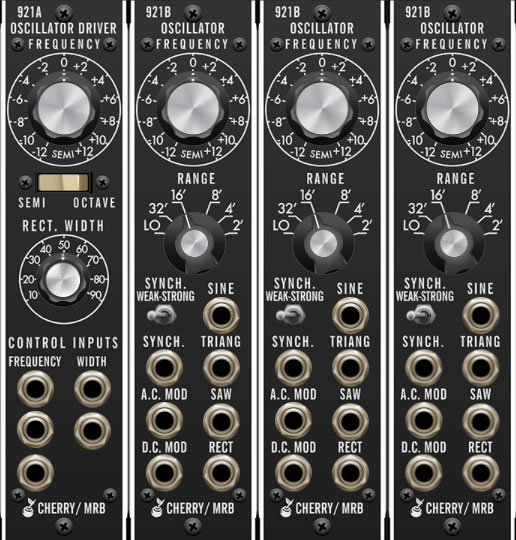
The VM921ABBB is an oscillator bank that replicates the unique oscillator driver/slave arrangement of a classic modular synthesizer. The concept is that the the Oscillator Driver module sets the overall coarse tuning as well as rectangular wave pulse width for the three slave oscillators. In the original hardware modular systems, the oscillator driver and slaves were connected internally. Any number of slave oscillators could be used, but the "one+three" combo was common, and we felt it represented a good compromise of utility and size. Though these have the appearance of four individual single-width modules, VM901ABBB is a single quad-width module. If you need something physically narrower, use the VM921 oscillator module.
921A Oscillator Driver
The oscillator driver is the "master control" center; all of its control settings will affect the three slave oscillators. Changing its Frequency setting will equally offset all three slave oscillators, for example.
Inputs, Outputs, and Controls
Frequency- Continuously sets the frequency range to +/- 12 semitones or +/- 6 octaves depending on the Semitone/Octave switch setting.
Semitone/Octave switch- Sets the Frequency knob range to +/- 12 semitones or +/- 6 octaves .
Width Of Rectangular Wave (Pulse Width) - Sets the width or "duty-cycle" of slave oscillator rectangular (aka, pulse) waves. It has no effect on any other waveform. Its default setting of 50% outputs a perfect square wave, rich in odd-order harmonics. Moving the knob left or right narrows its width as well as the thickness of sound until it almost disappears at its extremes.
Control Inputs/Frequency jacks- These are 1V/octave exponential inputs. They're used for pitch CV as well as modulating the oscillator frequency. All three jacks are the same and their incoming voltages are summed.
Control Inputs/Width jacks- Allows CV control of the width of slave oscillator rectangular (pulse) waves. Both jacks are the same; their input voltages are summed.
921B Slave Oscillators
As mentioned, 921A oscillator driver settings equally affect all three slave oscillators. Conversely, settings on individual 921B slave oscillators are independent and have no affect on the adjacent oscillators.
Inputs, Outputs, and Controls
Frequency- Continuously offsets the frequency range +/- 12 semitones or . This is useful for creating stacked-harmony "chords."
Range- Sets the base oscillator frequency in standard organ-style footage increments. The Lo setting is below the audible hearing range and is intended for modulation purposes (unless you enjoy the sound of "click-click-click.")
Synch. Weak-Strong and Synch In. jack- This type of vintage oscillator synch is unlike a conventional cycle reset type of synch, thus it doesn't lend itself to classic "tearing" sync sweep sounds. 921 oscillator synch is based on phase-lock-loop principles: the oscillator waveform and the incoming synch waveform are put through a phase comparator which outputs out a voltage proportional to the difference between the two frequencies. This voltage is added to the VCO control voltage sum as a kind of “error correction” signal in an attempt to bring the oscillator into tune with the synch signal. It’s akin to attempting to tune a guitar with a friend’s: you apply a “correction” to the tuning peg. However, the correction voltage is limited in strength. The weak/strong switch determines how far the correction can reach. What makes it interesting is that the phase comparator is sensitive to harmonics and will lock on to them as well. During a frequency sweep of one of the oscillators while the other is held still, you'll hear the tone grab on, get stretched, and then let go because the phase comparator loses its "magnetic" grip. It’s a unique sound, and it’s interesting to note that the 921 and the 921ABBB sport completely different synch capabilities.
Sine/Triangular/Sawtooth/Rectangular output jacks- Output jacks for all oscillator waves. These can be used simultaneously, or in any combination. These are always at full amplitude.
A.C. Modulate- AC-coupled linear modulation input. Preferred input for FM effects.
D.C. Modulate- DC-coupled linear modulation input.